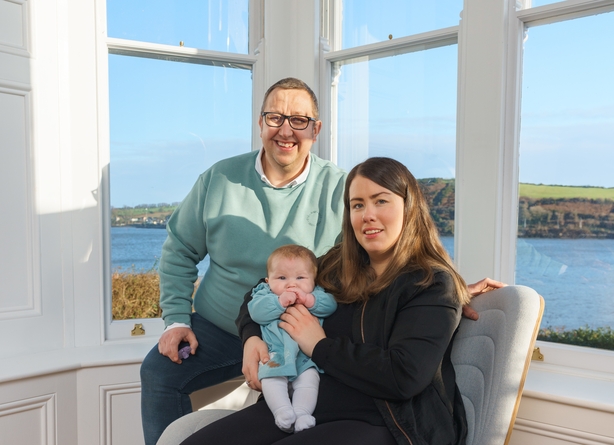There are, according to Hugh Wallace, 180,000 vacant properties in Ireland at the moment. Specifically, that's "90,000 in the countryside and 90,000 in our city's towns and villages, that doesn't include commercial property", he adds.
Many of these vacant homes are architectural gems, potentially striking homes that have been overlooked in favour of shiny new builds. What they need, however, is new blood and fresh perspectives, which is just what the cast of the newest season of The Great House Revival brings to the table.
This time around, the show focuses on the cohort of young restorers who are turning ruinous wrecks into handsome homes. Drawing on the popularity of home restorers on social media, the show follows ambitious homeowners who find inspiration in the country's often forgotten properties.

"I think in the past, a lot of people moved out of the towns and villages because of the quality of the living conditions", host Wallace says. "And that spawned the linear development bungalows, so people moved out of the towns and villages into their bungalow because the houses in the town were seen as being part of our past, our poverty.
"And now that's changed. Now these buildings are seen as opportunities to live in our towns and villages. Walk out the door, go and have a coffee. Meet the friends, go to the local butcher, baker and candlestick maker."
The builds featured on the show this year are "modern, fresh takes on an old building, but respecting the historical aspects of those buildings", he says.
Among them is that of tech professional Rob Hennessy, who transformed a bargain-price Victorian house on the banks of the Lee into a chic and comfortable home – all on the slimmest of budgets, while meeting the love of his life and welcoming a baby girl, Caoimhe, in the span of two years.

"Rob has respected the heritage of that home, but he's also made it a very crisp, modern home. Amazing kitchen, open plan, yummy materials."
Another episode focuses on a restoration in Sigginstown, where an eccentric American couple who are into mediaeval reenactments, bought a tower house in Co. Wexford and are restoring it. "That, to me, is amazing because they decided to approach the restoration and conservation by using the materials and methods of the day when the tower house was built", Wallace says.
Retaining a spirit of the original build is essential, of course, but how do you know where the line between comfort and modernity, and original craftsmanship lies? It depends on the house, Wallace says.
"Each home will have elements that are important to retain for our historical architecture. But in an awful lot of cases, there are so few buildings actually listed in Ireland, it's amazing. You need to be comfortable that what you're doing isn't destroying a historical fabric of that building.
The Great House Revival returns this Sunday! Up first are Rob and Katie, who are restoring a Victorian house on the banks of the Lee with the added time pressure of a new arrival on the way... 👶#TheGreatHouseRevival, Sunday at 9.30pm | @rteplayer | @architecthugh pic.twitter.com/pAOz9BUJrN
— RTÉ One (@RTEOne) March 22, 2022
"[It] could be as simple as [keeping] the glass in the windows, because there's very little glass from the 17th, 18th and early 19th century left in the country. So that might be your nod to the past."
What has kept younger people moving back to towns and villages? "I think still there's sort of a snob value of, I'm not living in the middle of my little village or my little town", Wallace says. But as lifestyles change thanks to the pandemic or the rising costs of living, he says we have to start adapting.
For example, "We all have to understand that we all have to make an attempt to live without a car. In my opinion, the only way to do that is to move back into our towns and villages, provide proper public transport."
After the pandemic and the rise of remote working, many young people decided to move away from the high rents of the city and return to more rural communities. However, they aren't reaching the areas that they need to, Wallace says.
"They actually haven't gone into the main street and they need to go back into the main street. But that has obstacles because of legislation, particularly to do with building control and requirements of building control", he says. So what ends up happening is, "you're forcing conditions for a new build on an old building and the two don't marry. And that involves additional cost".
Steep costs is one of many obstacles stopping would-be homeowners finding their forever home and renovating it as they'd like, but Wallace says the young restorers on The Great House Revival prove that costs can be cut by getting stuck in yourself.
"[The builds] are only realistic because people who are doing the work are rolling up their sleeves and doing all the hard lifting", he says. "They're the ones stripping all the walls, removing all the rubble. And that is where the money disappears.
"You need to be involved in research. You need to understand what you're doing."
And if you're thinking of undertaking a restoration project with your partner and family, like Rob Hennessy or Wallace himself – who is about to start renovating his fifth house with his husband Martin – how can you avoid tearing each other's hair out?
"Keep a sense of humour", the star architect says. "Otherwise you can get in a rabbit hole and the project and the love of your life and the dreams can become a nightmare and you shouldn't let that happen."
Watch The Great House Revival on Sundays at 9:30pm on RTÉ One.


